duet
Schnauber - A Little Grand Wedding March Waltz - Piccolo and Trombone
 A Little Grand Wedding March Waltz, by Tom Schnauber
A Little Grand Wedding March Waltz, by Tom Schnauber
Score for Piccolo and Trombone, PDF $4.99
This piece was written for the wedding of two good friends of mine from graduate school. One was a trombonist and the other a piccolo specialist. It was conceived in the lovely tradition of Hausmusik: short, simple, fun, and meant for two people to play with each other or for friends. Also, though the score indicates trombone and piccolo, it should be equally satisfying with a cello or bassoon on the lower part and a standard flute on the upper. Or even contrabassoon and piccolo . . . whatever you have available. —Tom Schnauber
Score, 3 pages; Total, 4 pages
PreviewSchnauber - Not-Pooh Songs - Female Voice and Flute or Female Voice and Oboe
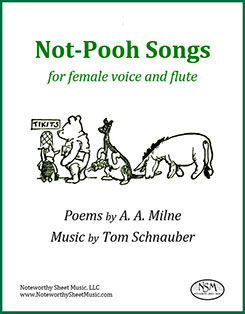 Not-Pooh Songs, by Tom Schnauber
Not-Pooh Songs, by Tom Schnauber
For Female Voice and Flute or Female Voice and Oboe, 2 editions
Score for Female Voice and Flute, PDF $18.46
Score for Female Voice and Oboe, PDF $18.46
Tom Schnauber’s Not-Pooh Songs are absolutely delightful. The composer has set to music six children’s poems by A. A. Milne, four from When We Were Very Very Young (“The Alchemist”, “The Mirror”, “The Four Friends”, and “If I Were King”) and two from Now We Are Six ("The Charcoal Burner" and "The Engineer"). The work is offered by Noteworthy Sheet Music, LLC in two publications, one for female voice and flute, the other for female voice and oboe. The oboe line is sufficiently different from the flute line in terms of register to warrant it being published as a separate edition (i.e., the flute version makes use of that instrument’s wider range by putting some material in higher octaves). Also, the flute edition includes an alternate variation of “The Mirror” for voice and alto flute, whereas the oboe edition includes an alternate variation of “The Mirror” for voice and English horn.
It’s clear from hearing this music that Schnauber gets a real kick out of Milne’s poetry. The flute/oboe comments, echoes, etc. go with or against the voice line very effectively and entertainingly. These songs will have broad appeal to both players and audiences, and there’s a lot that a pair of performers could do with them. The music isn’t easy, but provides just the sort of challenges that the adventuresome player loves; in places, for example, the flute jumps from C7 to C4, plays multiphonics, and executes finger snaps. But, as the composer has pointed out, just because the music is somewhat demanding doesn’t mean that it should be presented seriously in performance; on the contrary, players should have fun with these pieces and convey the intended joy and playfulness of the work.
Note that both performers are to play from the score, so flutists and oboists may want to print their copy of the score single-sided to avoid a few difficult page turns.
To listen to a recording of Not-Pooh Songs performed by Mitsi Westra, voice, and Pamela French, oboe, visit Tom Schnauber’s SoundCloud page at https://soundcloud.com/user-557772917/sets/not-pooh-songs.
► Schnauber - Not-Pooh Songs - Voice and Flute - PDF

Preview: Not-Pooh Songs for Voice and Flute, p1
Score for female voice and flute, 22 pages; Lyrics, 2 pages; Total, 28 pages.
► Schnauber - Not-Pooh Songs - Voice and Oboe - PDF
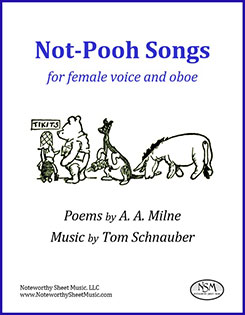
Preview: Not-Pooh Songs for Voice and Oboe, p7
Score for female voice and oboe, 22 pages; Lyrics, 2 pages; Total 28 pages
Schnauber - Those Infernal Exsanguinators - Flute and Piano
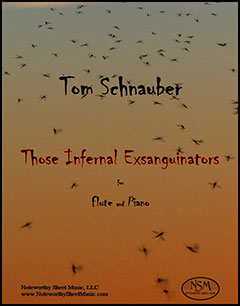 Those Infernal Exsanguinators, by Tom Schnauber
Those Infernal Exsanguinators, by Tom Schnauber
Flute part and Piano score, PDF $17.97
Summer in Minnesota. The sun is setting, the broad sky is clear, and the cool light of dusk promises a welcome respite from the day’s heat and humidity. You step out into the stillness and stand, gazing at the orange-red horizon, thankful for the dimming light and approaching night. And then they come. Those insidious little creatures, those vile insects that define and destroy the season: the mosquitoes. Only some at first, few enough to make you think that if you swat them away, you can still enjoy the evening air. But then more come, and more, and even more. They whine, you moan, they sting, you slap, they swarm, you flail. Soon, your body a mass of swelling welts, you realize that the twilight peace you had hoped for when you left your house is a sham, an impossible illusion shattered by the piercing terror of those infernal exsanguinators. Angry and itching, you run back inside and slam the door shut. —Tom Schnauber
In October, 2020, we at NSM were delighted to welcome Tom Schnauber as one of our contributing contemporary composers; click the link to read about this acclaimed composer's career and his many exciting projects.
Those Infernal Exsanguinators is a compelling piece; to discover this for yourself, please visit Tom Schnauber's soundcloud page and listen to a recording of the work beautifully performed by Tamara Thweatt, flute, and Hey-Seon Choi, piano.
Piano Score, 18 pages; Flute part, 7 pages; Total, 28 pages.
PreviewSchubert - Rondo in B minor - Flute (and Piano)
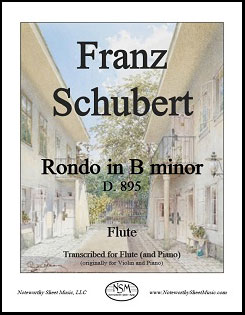 Rondo in B minor, D.895, by Franz Schubert
Rondo in B minor, D.895, by Franz Schubert
Transcribed for Flute (and Piano) by J.W.Pratt and C.A.Vater
Flute Part, PDF $11.99
The Rondo in B minor, D.895 (alternatively known as Rondeau brillant) was written for violin and piano in 1826 by the great Austrian composer Franz Peter Schubert. Dedicated to the young violin virtuoso Josef Slawjk, the Rondo is demanding in both the solo and piano parts. The work consists of an Andante introduction and an Allegro rondo, and is quite long at 713 measures and typically some thirteen minutes or more in duration. Inexplicably, the piece is less familiar to players and audiences than many of Schubert’s other works. Brian Newbould, renowned composer, conductor, author, and Schubert expert, wrote of the Rondo in his treatise Schubert: The Music and the Man (University of California Press, Jan 1, 1997, p365): “Not surprisingly, perhaps, it is little known because it is seldom played. But it is also undervalued: it scintillates, dances and sings, with a blend of infectious joy, tireless energy, rhythmic zip and ‒ from time to time ‒ heart-melting turns of melody and harmony.”
These characteristics and the way the music realizes them are not only suitable to but often even suggestive of a wind instrument. Our transcription provides effective flute-friendly alternatives for the violin’s double-stops as well as for notes that fall below the flute’s range, so the piece can be played comfortably and beautifully on flute. The Rondo is virtuosic in places, showy and exciting, and overall great fun to play. The Noteworthy Sheet Music edition of our transcribed flute part does not include a re-notated copy of the score, since high-quality PDFs of the piano and violin score are freely available in the public domain and are sufficient to use along with our flute part, in lieu of violin. To download one such PDF of the score, please visit the Rondo’s page on IMSLP.
Flute part, 12 pages; Total 14 pages.
PreviewSchubert - Sonatas, Op.137 - Alto Flute
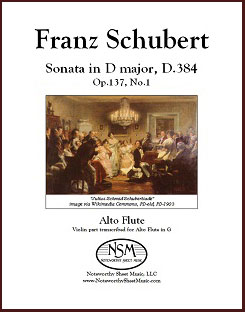 Sonatas, Op.137, by F. Schubert
Sonatas, Op.137, by F. Schubert
Transcribed for Alto Flute and Piano by C. A. Vater & J. W. Pratt
No.1, Sonata in D major, D.384, Alto Flute Part, PDF $5.99No.2, Sonata in A minor, D.385, Alto Flute Part, PDF $7.99
No.3, Sonata in G minor, D.408, Alto Flute Part, PDF $5.99
Franz Schubert (1797-1828) wrote his three violin sonatas Opus 137 when he was barely 19. They were published posthumously as 'Sonatinas', perhaps for marketing reasons, but they are full-scale sonatas in traditional classical style and format, the first having three movements and the others four. These plus the violin sonata in A of the next year constitute fully half of Schubert's known works for piano and solo instrument.
Schubert's Op.137 sonatas are truly delightful, and we have adapted the violin parts for alto flute. Where appropriate, changes have been introduced to better accommodate the range, sonority, and general characteristics of the alto flute. Such modifications include occasional octave adjustments, dynamic changes, and suitable flute-friendly alternatives to the violin's doublestops. We provide our transcribed alto flute parts; the piano scores are readily available in the public domain as free pdf downloads from imslp.org/.
No.1, Sonata in D major: Alto Flute part, 6 pages; Total, 8 pages. PDF $5.99
Preview
Preview
No.3, Sonata in G minor: Alto Flute part, 6 pages; Total, 8 pages. PDF $5.99
Preview
Schubert – Erlking – Duo (Vo, Vc, Va, or Afl with Pf)
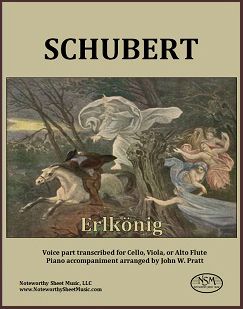 Erlkönig, by Franz Schubert
Erlkönig, by Franz Schubert
Arranged for Cello (or Viola or Alto Flute) and Piano by John W. Pratt
Piano Score and Parts for Cello/Voice, Viola, and Alto Flute; PDF $11.99
Franz Schubert (1797-1828), inspired by reading Goethe's poem, wrote his song "Erlkönig" in a few hours in 1815. The song was an immediate hit, and continues to be popular to the present day. John Pratt has created a trio arrangement for flute, cello, and piano (click for more information), and also the duo version offered here with Schubert's solo voice part transposed for cello (or viola or alto flute), and with a less arduous alternative to Schubert's piano accompaniment.
Excerpted from Mr. Pratt's © preface:
"In the duo arrangement, Schubert's solo part is adopted without change. Thus the piano must provide the entire accompaniment, but rocking triplets and other pianistically felicitous passagework replace Schubert's unremitting repetition. The range of sonorities is also wider than Schubert's, though more restrained than that of the trio arrangement, where the flute enlarges the musical terrain. This accompaniment is offered as a less punishing alternative to Schubert's, to be played with a singer or any solo instrument. Solo parts are provided for voice or cello, viola, and alto flute."
Piano score, 6 pages; Cello, Viola, and Alto Flute parts, 2 pages each; Total, 22 pages.
PreviewSchumann - Drei Romanzen - Alto Flute
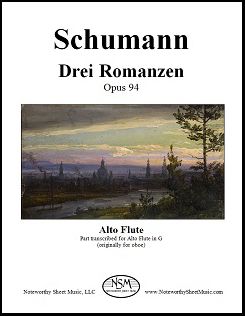 Drei Romanzen, Op.94, by Robert Schumann
Drei Romanzen, Op.94, by Robert Schumann
Transcribed for Alto Flute (and Piano) by Carol A. Vater
Alto Flute Part, PDF $6.49
Robert Schumann composed his Drei Romanzen (Opus 94) for oboe and piano in 1849, and Simrock published the first edition, Drei Romanzen für Hoboe, ad libitum Violine oder Clarinette, mit Begleitung des Pianoforte, in 1851. Others have created arrangements of this popular piece for additional instruments, including cello, alto sax, soprano sax, tuba, flute, and horn. The 3 Romances are beautifully adaptable to the alto flute’s range and sonority. We provide here the alto flute part; the piano part is readily available in the public domain, free, as a pdf download of the score for oboe and piano. Here is a link to one such source: Piano Score.
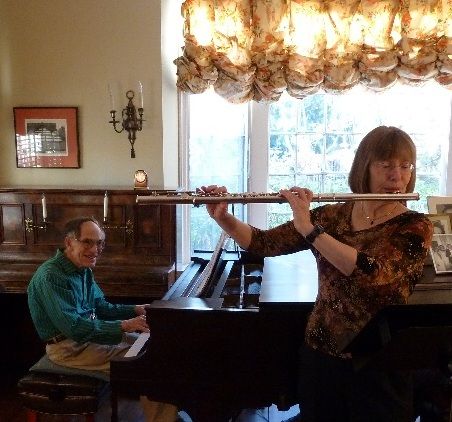 Alto Flute part, 6 pages; Total, 8 pages
Alto Flute part, 6 pages; Total, 8 pages
Schumann - Fantasy Pieces - Alto Flute
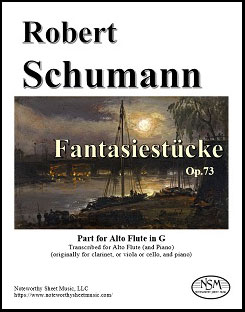 Fantasiestücke, Op.73, by Robert Schumann
Fantasiestücke, Op.73, by Robert Schumann
Transcribed for Alto Flute (and Piano) by Carol A. Vater
Alto Flute Part, PDF $6.96
Robert Schumann composed his Fantasiestücke (Fantasy Pieces) for clarinet and piano, but also arranged them for cello with piano. Others have since created arrangements of this highly popular and frequently performed piece for a variety of additional instruments. The Fantasy Pieces are charmingly adaptable as a work for alto flute and piano, and we offer here our alto flute transcription of the solo part. The edition does not include the piano part, but a suitable version is readily available in the public domain as a free pdf download of the score for clarinet and piano. Here is a link to one such source: Piano Score.
Alto Flute part, 6 pages; Total, 8 pages.
PreviewSchumann - Five Pieces in Folk Style - Alto Flute
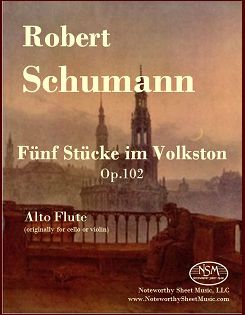 Fünf Stücke im Volkston, Op.102, by Robert Schumann
Fünf Stücke im Volkston, Op.102, by Robert Schumann
Transcribed for Alto Flute (and Piano) by John W. Pratt
Alto Flute Part, PDF $6.99
Excerpted from the foreword by John W. Pratt:We provide our transcribed alto flute part only; the piano score is in the public domain and available without charge from imslp.org.
Alto Flute part, 6 pages; Total, 10 pages.
PreviewSchumann - Märchenbilder - Alto Flute
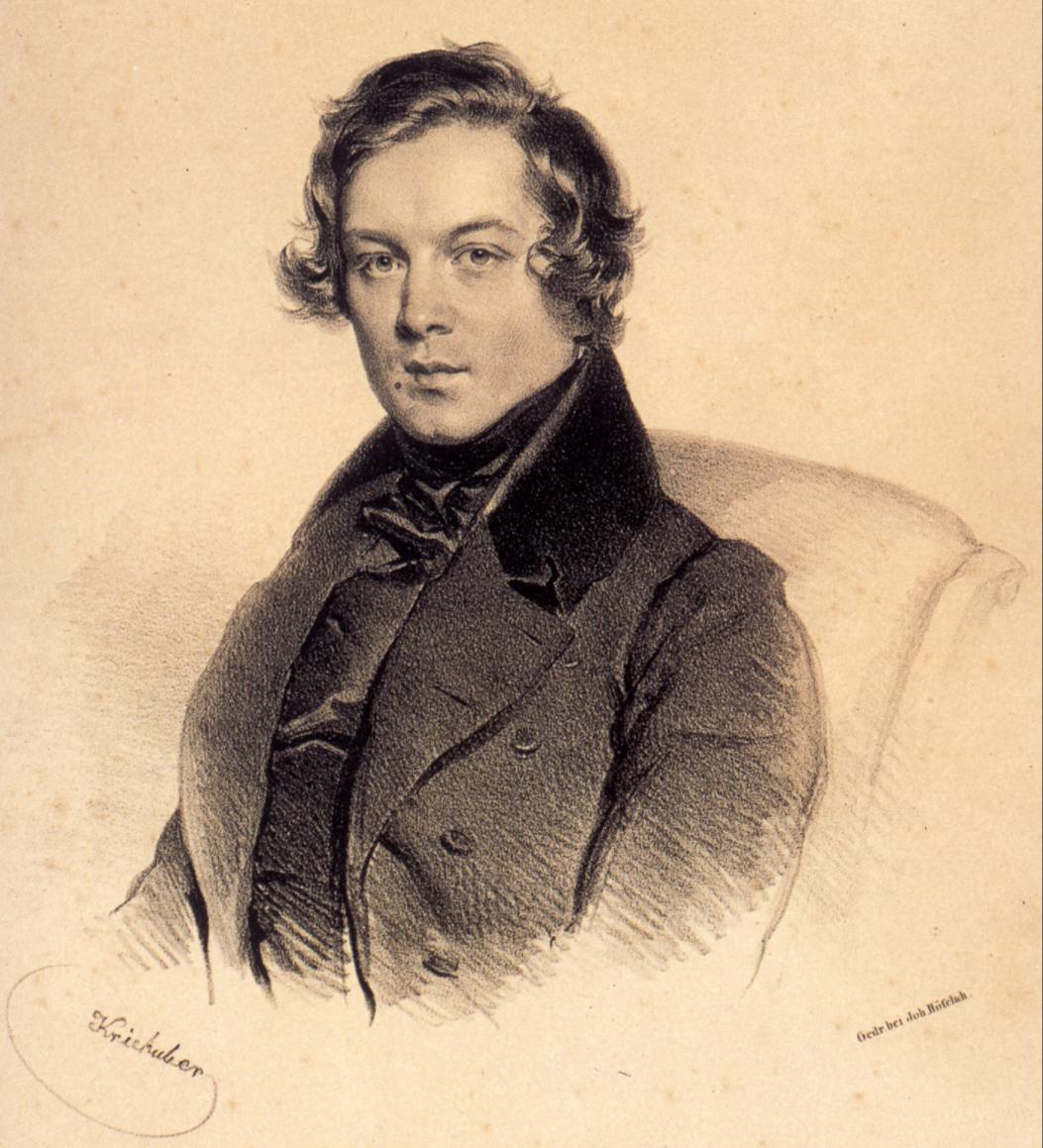 Märchenbilder, Op.113, by Robert Schumann
Märchenbilder, Op.113, by Robert Schumann
Transcribed for Alto Flute (and Piano) by J.W.Pratt & C.A.Vater
Alto Flute Part, PDF $9.98
Alto Flute Part, 10 pages; Total, 12 pages.
Preview